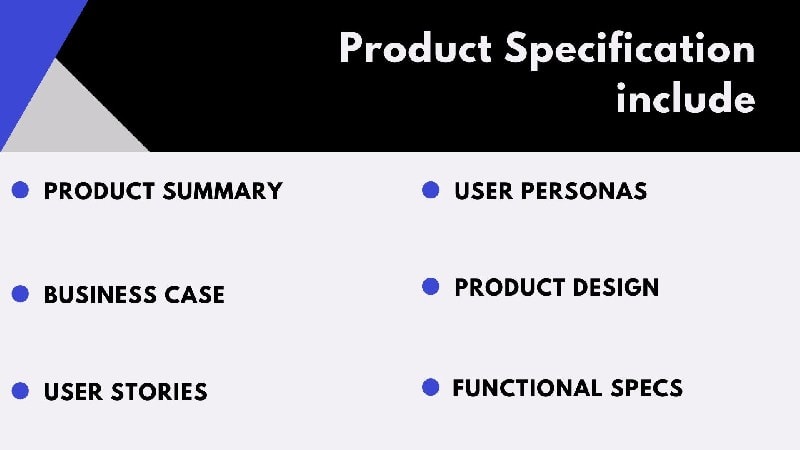When a product is conceptualized, its requirements and specifications are documented so that the product teams can understand what the product will be, how it will look and what sorts of functions it will perform. This blueprint including product details is perceived as product specifications.
It is also termed as Product Specs, and it informs product teams about the product summary, potential users, user stories, and other essential details, so they can make the best decisions while designing the product.
In this article, we will be unraveling different layers of product specification and understand what should be incorporated under a product specification. So, without any further ado, let us get started right away-
Table of Contents
What are Product Specifications?
Product Specification is the process of listing down all the aspects and features that are required to be present in the product in a strategic way. It is a document that contains all the requirements that are aimed to be in the product.
Manufacturing a product and delivering it is one side of the story, the actual work starts when it is to be presented theoretically to create that product considering the competition in the market.
It is essential to mention all the specifications of the product before starting to create it. Product Specification comes in play here.
It is a step-wise process wherein every detail holds importance.
One cannot merely dive into what the product is going to be or how it is going to bring into the application; he or she needs to mention all the stages involved in building that product.
These stages form the foundation of a product.
Why is Product Specification Important?
The concept behind having product specifications is to provide the assigned team to create the product, a detailed overview of what all features should be embedded in the product to get the desired result.
If adequately defined product specifications are prepared, then it is sufficient enough to give the team members insight into the business needs, knowledge about targeted customers or users, and the financial limits. If the team is aware of all these factors, then the task of designing appropriate solutions becomes easy and smooth.
A well-versed product specification will have clarity and transparency, which in turn will give more clarity to the team working on creating the product.
Common Questions to ask while building Product Specification
Since a product specification lays out the requirements of a product, it needs to be informative but neither too long nor highly technical.
Keeping a product spec brief and to the point proves in the creation of a successful product and increases its efficiency.
To make a product specification easy to read as well informed, one must be able to answer these few questions with utmost ease:
1) What is to be created?
The type and nature of the product must be well known. There should be the right mindset.
2) What is the need for its creation, and what is its usage?
The purpose of the product should be known and the audience that it is supposed to impact eventually. Having specific knowledge about the usage of the product is a must.
3) What can be expected from the final result?
One must be aware of and prepared for the kind of result that is going to be achieved.
4) How can the outcome be predicted?
Proper, systematic, and strategic planning of the development of the product should be done.
If one has an answer to all these questions in a satisfactory way, then the approach is transparent, and on the right path; otherwise, one must reconsider.
What does a Product Specification include?
Listed below are the elements that a product specification includes that help it to be informative enough from the working team’s point of view. These are;
1) Product Summary
A product summary is one of the significant parts of a product’s specifications. It briefly explains the product on specific parameters.
These include the basic idea behind its production, the need for creating the product, its expected delivery, estimated time that it’ll take until finished, and how the final product would look.
A summary is to give a rough idea to the readers of what they can expect and is usually the initial step in the process of attracting customers as it brings the features to light.
2) Business Case
A business case is essential from the company’s growth perspective.
It is a drafted deed that draws a boundary around the advantages or incentives received from the production of the product that will benefit the company and improve its market value in the industry and is thus included to develop the product.
Moreover, the business case also sheds light on the company’s monetary bounds and resources that would suffice to complete the project.
3) User Stories
This element is crucial as it determines how big the audience will be.
It is the iteration from a customer or user’s point of view of how useful a product is or what are its highs and lows.
These include the features that a user wants to see in the newer products. These brief user messages are vital to gain a vast audience.
4) User Personas
Here, the details about the targeted audience must be introduced, such as who will use the product. If the user persona is used effectively and strategically, then it will clearly describe a character that fits in wholly based on the target demographics.
If the target is pre-defined, it gets easier for the team working on the product to envision a product and design it while keeping it customer-centric.
5) Product Design
A rough sketch of the product needs to be formulated before starting with the physical design. Hence, a technical drawing becomes mandatory during the process.
It is essential because if there are any changes, then they can be easily made in the sketch instead of disturbing the main design later.
The visual representation helps create an estimation of how the final product will look like, and based on it; management processes can be carried out.
6) Functional Specs
A functional spec is included in the end that majorly contains the operational aspects of the product, like the intended appearance and efficiency of the product as well as how it will be made to interact with users.
The entire functional documentation takes place at this stage.
This is usually set as the reference point, to begin with, all the programming and then to proceed further accordingly.
These elements need to be implanted in a product specification to make it resourceful and capable.
Missing onto any of these can make the specification less informative that might create a problem for the working team to design the desired product and hence deliver it.
Now, after being aware of the critical things that should be included in product specification, let us now go through the steps of writing a product specification-
How do you write a Product Specification?
- Defining the sources of problems
When you create a product, it must be designed for solving some problems or doing some tasks. So, to create your product specification, you need to make notes of the issues that your product will sort out.
- Using the feedback of the customers
Paying heed to the customers’ feedback is quite significant for making products that fit well with the customers’ needs. Taking insights from the customer feedback of a similar type of product and incorporating that into product specification is quite useful. Even you can come up with the product prototype for getting the user feedback.
- Determining and evaluating different requirements
Some specific requirements have to be included in the particular kinds of products, and you should evaluate and incorporate those requirements in your product specification.
- Breaking the particular problem into hypotheses
You need to make a supposition or proposed explanation based on the different problems that your product will resolve, and include that into your product specification.
- Adding the pages/screens with all the essential features
Your product specification should include different pages or screens related to the critical features of your product.
- Incorporating discussions across the product teams
There should be a discussion across the product and design team about the critical aspects of your product and excerpt that should be included in your product specification.
- Including user testing with your closest customers
You should also create a prototype of your product and do testing of that with your closest customers so that you can incorporate their test results into your product specification. This will help your product and design team to be more accurate with product development.
- Simplifying and Revising the product specification document
Before finalizing your product specification, you should simplify it and revise it, again and again, to make it more useful and impactful. You should continuously review and improve your product specification, so your product development team gets the most accurate and flawless document about the product.
After knowing about the steps that will help you in writing the product specification, the next thing upon which you need to pay heed to is the tools that can help you in creating product specifications. Therefore, let us have a look at some of the best tools for writing product specification-
Tools for creating Product Specification
Find the list of some of the most popular tools that can assist you in writing product specification-
- Axure RP
- Balsamiq (Software)
- StepShot Tool
- Aha!
- Pengloo
- Slite
Conclusion
Selling and building a suitable and sufficient market for a product; it is necessary to pay attention to its intricate details as the small elements only help in reaching the desired goal for a product.
With product specification, it gets easy to put forth the whole idea for a product on paper in a proper manner. It helps in strategizing and creating clear and sharp outlines as to what is required and what is not.
A product is assured to fulfill the demands of the company as well as the user if the Product
The specification is well written and useful.
How important do you consider the role of product specification in product development?
Did we miss any of the critical points that you consider essential for product specifications? Share your views with us in the comments below.
Liked this post? Check out the complete series on Product Management

